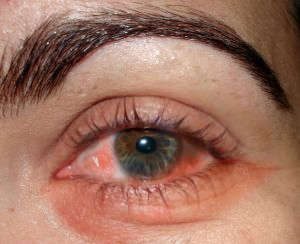CONJUCTIVITIS
Definition:

Conjunctivitis is an inflammation or swelling of the conjunctiva, which is an outermost covering of the eye and the inner eyelids. Most common causes of conjunctivitis include infections and allergies. Conjunctivitis can be acute (of short duration), chronic (long-lasting) or be recurring in nature. Conjunctivitis is probably the most common disorder of the eyes.
Symptoms:
- Redness
- Irritation
- Watering
- Thick, stringy discharge which may be yellowish or greenish in color
- Eye pain
- Swelling of the eye
- Sensation of particle in the eye
- Aversion to light
- Sneezing and runny nose in allergic conjunctivitis.
Causes:
It can be classified into two types:
A] Infectious conjunctivitis:
Infectious conjunctivitis is either bacterial or viral in origin and spreads to the other eye when one eye is infected. It also spreads to people coming in contact with the affected person.
B] Non-infectious conjunctivitis:
Non-infectious conjunctivitis occurs due to pollen or some foreign body or pollutants or dust or household cleaners, smoke, entering the eye, underlying diseases like rheumatoid arthritis, cytomegalovirus, lupus, Kawasaki’s disease, Ulcerative Colitis, Crohn’s Disease. It does not spread. Herpes can also cause non-infectious conjunctivitis. Chemical conjunctivitis is caused due to burns and exposure to toxic chemicals. Allergic conjunctivitis is accompanied by irritation and discharge from the nose as well which is worse in dry weather and better in moist weather.
Prevention:
Staying away from allergens is one way of preventing allergic conjunctivitis.
Washing the eyes, face, and hands frequently during the day prevents infectious conjunctivitis.
Staying away from crowded places and using personal towels and napkins and handkerchiefs prevents the disease from spreading to others.

